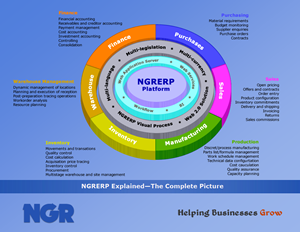Material Requirements Planning
NGRERP's material requirements planning (MRP) functionality ensures raw materials, ingredients, and packaging supplies are available for production, to readily meet customer order requirements while optimizing inventory levels for improved discrete and process manufacturing efficiency.
NGRERP's material requirements planning (MRP) software functionality performs time-phased requirements planning for single and multi-facility manufacturing organizations. This process calculates inventory requirements over time and automatically generates online purchase requisitions and tentative production schedules, which can be turned into purchase orders, inventory transfers, and final production schedules.
To generate the tentative production schedule, the MRP process uses customer demand in the form of sales orders and forecasts, inventory levels and associated replenishment methodologies, multi-level bills of material, routings, available production capacity, and supplier information such as lead times and purchase order requirements.
Furthermore, NGRERP's MRP process calculates expected inventory levels over time and generates purchase requisitions with appropriate time offsets to meet future projected inventory shortfalls. Buyers and material planners can review the purchase requisitions and automatically generate the necessary purchase orders and intercompany transfers to support the organization’s inventory plan.
NGRERP's manufacturing software functionality enables discrete, process, and mixed-mode manufacturers to generate purchase requisitions, tentative production schedules, and real-time alerts and notifications to create the material plan necessary to fulfill customer demand efficiently.
Material Requirements Planning (MRP) Highlights
- Performs time-phased requirements planning for single and multi-facility manufacturing organizations
- Generates online purchase requisitions and tentative production schedules
- Uses customer demand in the form of sales orders and forecasts
- Uses inventory levels and associated replenishment methodologies
- Uses multi-level bills of material, routings, and available production capacity
- Uses supplier information such as lead times and purchase order requirements
- Calculates expected inventory levels over time and generates purchase requisitions with appropriate time offsets to meet future projected inventory shortfall

